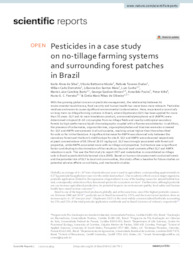Pesticides in a case study on no-tillage farming systems and surrounding forest patches in Brazil.
Pesticides in a case study on no-tillage farming systems and surrounding forest patches in Brazil.
Autoria: SILVA, K. A. da; NICOLA, V. B.; DUDAS, R. T.; DEMETRIO, W. C.; MAIA, L. dos S.; CUNHA, L.; BARTZ, M. L. C.; BROWN, G. G.; PASINI, A.; KILLE, P.; FERREIRA, N. G. C.; OLIVEIRA, C. M. R. de
Resumo: With the growing global concern on pesticide management, the relationship between its environmental recalcitrance, food security and human health has never been more relevant. Pesticides residues are known to cause significant environmental contamination. Here, we present a case study on long-term no-tillage farming systems in Brazil, where Glyphosate (GLY) has been applied for more than 35 years. GLY and its main breakdown product, aminomethylphosphonic acid (AMPA) were determined in topsoil (0–10 cm) samples from no-tillage fields and nearby subtropical secondary forests by high-performance liquid chromatography coupled with a fluorescence detector. In addition, the presence of carbamates, organochlorines, organophosphates and triazines were also screened for. GLY and AMPA were present in all soil samples, reaching values higher than those described for soils so far in the literature. A significant decrease for AMPA was observed only between the secondary forest and the farm’s middle slope for site B. GLY and AMPA were observed respectively at peak concentrations of 66.38 and 26.03 mg/kg soil. GLY was strongly associated with forest soil properties, while AMPA associated more with no-tillage soil properties. Soil texture was a significant factor contributing to discrimination of the results as clay and sand contents affect GLY and AMPA retention in soils. This was the first study to report DDT and metabolites in consolidated no-tillage soils in Brazil (a pesticide fully banned since 2009). Based on human risk assessment conducted herein and the potential risk of GLY to local soil communities, this study offers a baseline for future studies on potential adverse effects on soil biota, and mechanistic studies.
Ano de publicação: 2021
Tipo de publicação: Artigo de periódico
Unidade: Embrapa Florestas
Palavras-chave: Pesticidas, Pesticides, Plantio Direto, Solo Florestal
Observações
1 - Por padrão são exibidas publicações dos últimos 20 anos. Para encontrar publicações mais antigas, configure o filtro ano de publicação, colocando o ano a partir do qual você deseja encontrar publicações. O filtro está na coluna da esquerda na busca acima.
2 - Para ler algumas publicações da Embrapa (apenas as que estão em formato ePub), é necessário ter, no celular ou computador, um desses softwares gratuitos. Sistemas Android: Google Play Livros; IOS: iBooks; Windows e Linux: software Calibre.
Acesse outras publicações
Acesse a Base de Dados da Pesquisa Agropecuária (BDPA) para consultar o acervo completo das bibliotecas da Embrapa.

